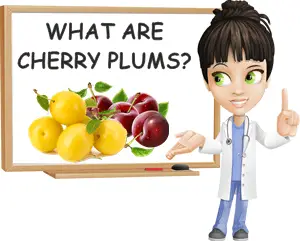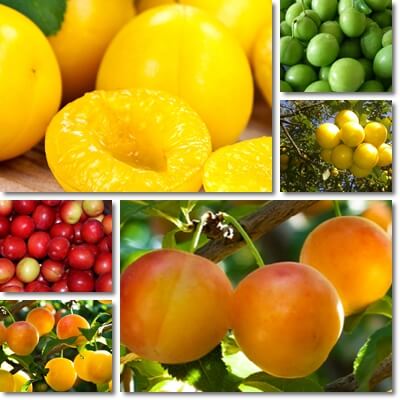Cherry plums are not actual plums, although they are related to them. The cherry plum is a seasonal summer fruit occurring naturally throughout the Northern and Southern hemisphere and in season right now, in summer.
The scientific name is Prunus cerasifera. An alternative common name for the cherry plum is the myrobalan plum, although it’s less commonly used.
Despite their name which presents them as a type of plum, cherry plums are not the same thing as plums, but rather a different, albeit related fruit.
The cherry plum is also related to apricots, sweet cherries, sour cherries, the bird cherry, sloe or blackthorn, the Japanese plum/apricot and the sweet almond.

What are the Origin of cherry plum?
The origins of the cherry plum are largely lost to documented history and the species is often regarded as an old world plant despite surviving and even thriving to the present day. Available historical documents attest the cultivation of cherry plums in Persia and, more recently, the Balkan region of Europe and parts of West and Central Asia.
The native habitat of cherry plums extends to include all of Central and Eastern Europe and West/Southwest and Central Asia.
The species has been introduced to North America, Canada, Australia, most of Asia, and adapted beautifully. Even today, cherry plums are present in large numbers throughout the Balkans region of Europe and the Middle East, occurring naturally in the wild.
The scientific name, Prunus cerasus, indicates the cherry plum belongs to the Rose family (originally: Rosaceae). It’s closely related to other common botanical fruits of great economic importance such as plums, apricots, sweet cherries, sour cherries and sweet almonds.
Both the tree and the fruit go by the same name in the English speaking world: cherry plum or, less commonly, myrobalan plum.
Some sources also use the name ‘mirabelle’ plum to denominate varieties of yellow cherry plum or, more rarely, all cherry plums, but the mirabelle or the mirabelle plum is not the same thing as the cherry plum.

When is cherry plum season?
Cherry plum season in the Northern hemisphere is largely mid-June to mid-September for all varieties including early season, mid season and late season varieties. The season per variety lasts 3 to 4 weeks on average; during this time the fruits ripen gradually on the tree and require prompt harvesting.
If cherry plums are not harvested from the tree once ripe, the tree will drop them to the ground where they will start to ferment and spoil within 1-2 days.
Yellow cherry plums tend to spoil faster than red-violet varieties.
Early season cherry plums are ripe and ready to harvest starting mid-June and are in season until mid-July at the latest. Most early season cherry plums are yellow varieties.
Mid-season cherry plums include both golden yellow and red-violet varieties and are in season mid-July to mid-late August.
Late season cherry plums are red-violet or a dark red-plum color when ripe and in season mid to late August to mid-September.
Variations in the start and end of the harvest season for cherry plums are brought on primarily by factors such as variety, region of cultivation and climate.
Yearly weather variations can also shift the beginning and end of the harvest season for the fruit species by a few weeks.
Similarly, flowering season ranges from mid-February at the earliest to mid to late April at the latest depending on the region of cultivation, yearly weather variations and, of course, variety.
What do yellow cherry plums look like?
Cherry plums are circular in shape, with an indentation at the end with the stem and a fine line going across one side of the fruit from the end with the stem to the end opposite to the stem. The skin is thin and always smooth. Unripe and ripe fruits have a wax coating that dulls the skin color, but which can be rubbed off or washed off revealing a brighter pigment.
The flesh is tough and crisp in the underripe fruit, but soft and juicy in the ripe fruit. Overripe cherry plums become mushy and ferment.
Some varieties are more pulpy, with a soft, creamy flesh, while others have more juice than actual pulp.
Being drupes, the fruits have one central stone or pit that is a lighter brown color and contains one milky white bitter seed.
Cherry plum pits and seeds are mildly toxic and thus not edible.
There are quite a few different varieties of the fruit. The simplest classification includes 4 main types according to fruit color at maturity.
- Yellow cherry plums.
- Yellow cherry plums blushed with pink-red or peach.
- Red-violet cherry plums, some a uniform color, some blushed, some speckled.
- Dark purple cherry plums.
All unripe cherry plums are a light, somewhat pale green, but gradually change color as they ripen.
Yellow varieties go from a light green to greenish-yellow to a medium yellow to deep golden yellow, sometimes speckled with orange-red or blushed with peach. The pulp is usually always a deep yellow.
There is also an intermediate variety of cherry plum with both yellow and pink-red or peach skin and golden yellow skin.
Red-violet varieties go from a light green to a pink-red, sometimes blushed with peach, and ultimately turn a deeper red-violet color.
They can be one color all over, speckled, or blushed with yellow green when every so slightly underripe or peach when ripe. The flesh is either a golden yellow or peach color or violet-red, one or two tones lighter than the skin.
And lastly, very dark colored cherry plums go from pale green to red-violet to a very deep reddish purple or dark purple color. This variety is usually very uniform colored and has a very dark, reddish-violet flesh.
What do yellow cherry plums taste like?
Unripe cherry plums are very sour tasting, with a tough, hard flesh. As they ripen, the flesh becomes softer and juicier and various flavors develop depending on the variety. Different colors will taste differently.
Yellow cherry plums are mellow, that is, soft, sweet, juicy, and full of complex flavor. The yellow types have quite a straightforward and pregnant sweet taste with very little to no acidity. The flesh is very soft, with a warm and decidedly fruity flavor with apricot and honeydew melon notes and a strong fruity scent. The variety does not store well.
Yellow and pink red cherry plums are more on the acidic side, with a crisper flesh and moderate sweetness. The sweet taste is slightly overpowered by the acidic flavor, but the fruit is quite fresh tasting and great for eating raw. The variety stores well.
Red-violet and dark purple cherry plums have a balanced flavor profile reuniting sweet and tangy flavors over a strongly scented fruity base. Pigmented anthocyanin antioxidants that give the fruit its dark color are responsible for the tangy flavors in the skin and flesh of the ripe fruit. The variety has a soft, but firm flesh and is on the meatier side.
Cherry plums popular uses
Presently there is little interest in the species due to its reduced commercial importance compared to other culinary and botanical fruits.
The cherry plum is an extremely versatile fruit, with many diverse uses:
- Cherry plums are great fruit to eat raw and the different colors account for all taste preferences.
- You can cook with cherry plums and make sponge cakes and preserves such as jam and marmalade.
- Red-violet and dark purple cherry plums are commonly used to make a traditional fruit soup popular in the Balkan region.
- Unripe cherry plums can be used to sour soups and broths, either whole or pureed.
- Both the ripe (usually dark purple) and unripe fruit can be used to make a tangy sauce called simply ‘cherry plum sauce’ or ‘Tkemali’ (popular in Georgian cuisine). The sauce is great for tendering meat or simply used as such on cooked meat.
- Cherry plums have a good sugar content and ferment easily – they are great for making alcoholic beverages such as a colorless fruit brandy-of-sorts called ‘eau de vie’ in France (literally translating to ‘life water’), palincă or tuică in Romania, pálinka in Hungary and Austria, or pálenka in the Czech Republic, Poland and Slovakia.
- You can make juice and smoothies from fresh cherry plums and compote (a fruit stew with stewed fruit pieces and lots of sweet liquid).
- The tree species is extensively cultivated for uses such as rootstock for tree grafting, primarily for fruit trees such as pears, apricots, peaches and more.
Nutrition facts and benefits
The cherry plum has little value as a medicinal plant or nutraceutical, although it’s being promoted as such. It is indeed a modestly nutritious fruit with only small amounts of most essential vitamins and minerals.
The nutrition of cherry plums is on par with that of foods such as tomatoes and plums and includes modest amounts of vitamin C, provitamin A and small amounts of most B vitamins, except for vitamin B12, and minerals such as calcium, copper, iron, magnesium, potassium, phosphorus and zinc.
One of the biggest nutritional benefits of cherry plums is their good content of pectin which holds benefits for both diarrhea and constipation. When consumed in slightly larger amounts, the ripe fruits are purgative and depurative, helping cleanse the digestive system.
Yellow cherry plums in particular are good to eat for gastritis. Pectin in the ripe fruit is soothing on the stomach lining and calms irritation, lowering the incidence of flareups and actively encouraging healing. Not just this, but the yellow varieties are also low in acidity which makes them good to eat in GERD.
Cherry plums are very low in calories, almost free of fat and cholesterol free which recommends them for weight loss diets and high cholesterol. The ripe fruit help correct low blood sugar and boost energy levels, exerting a tonic, revitalizing effect.
